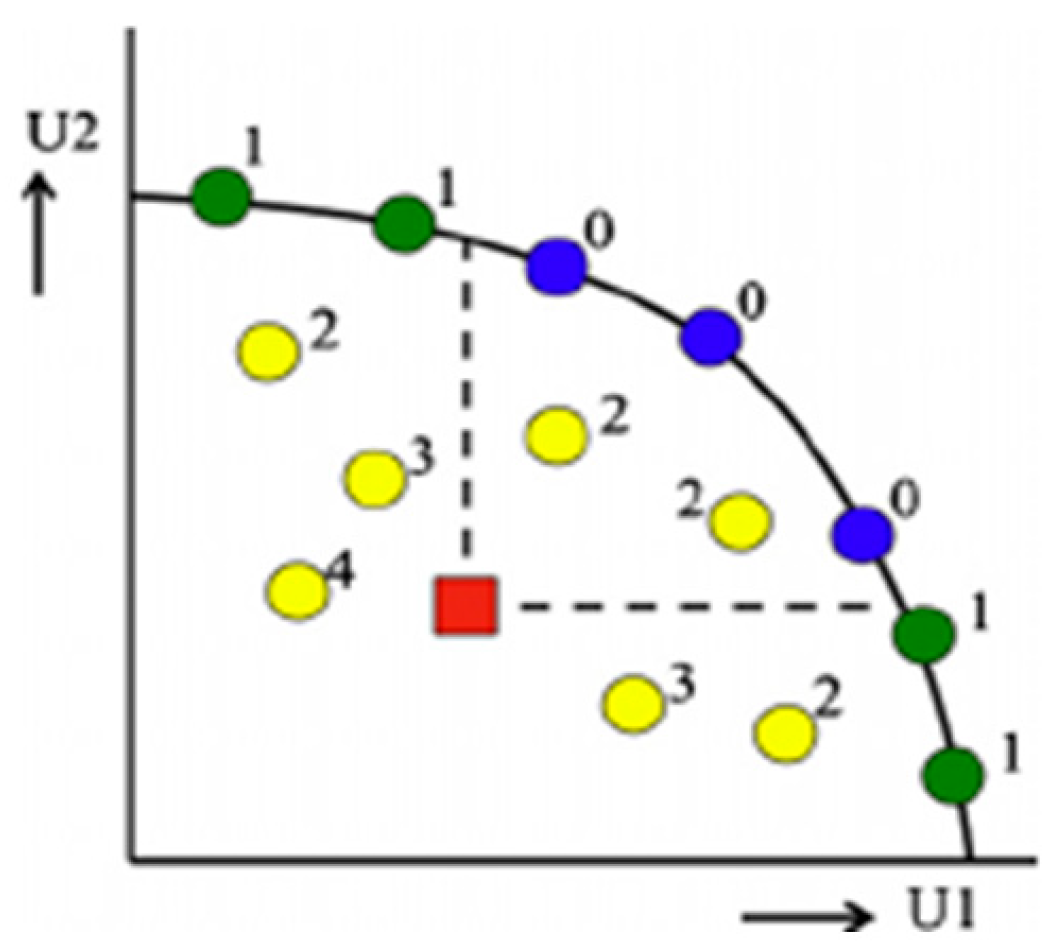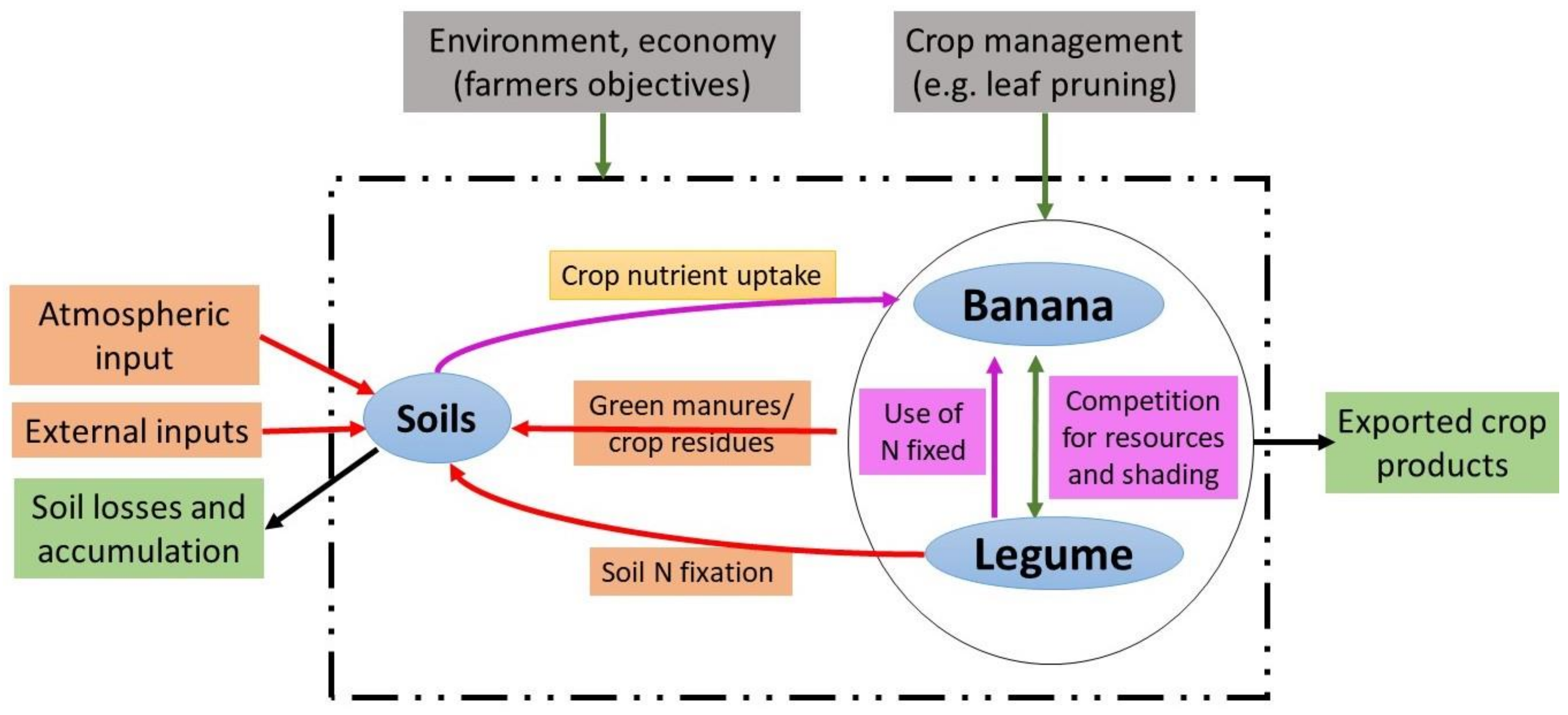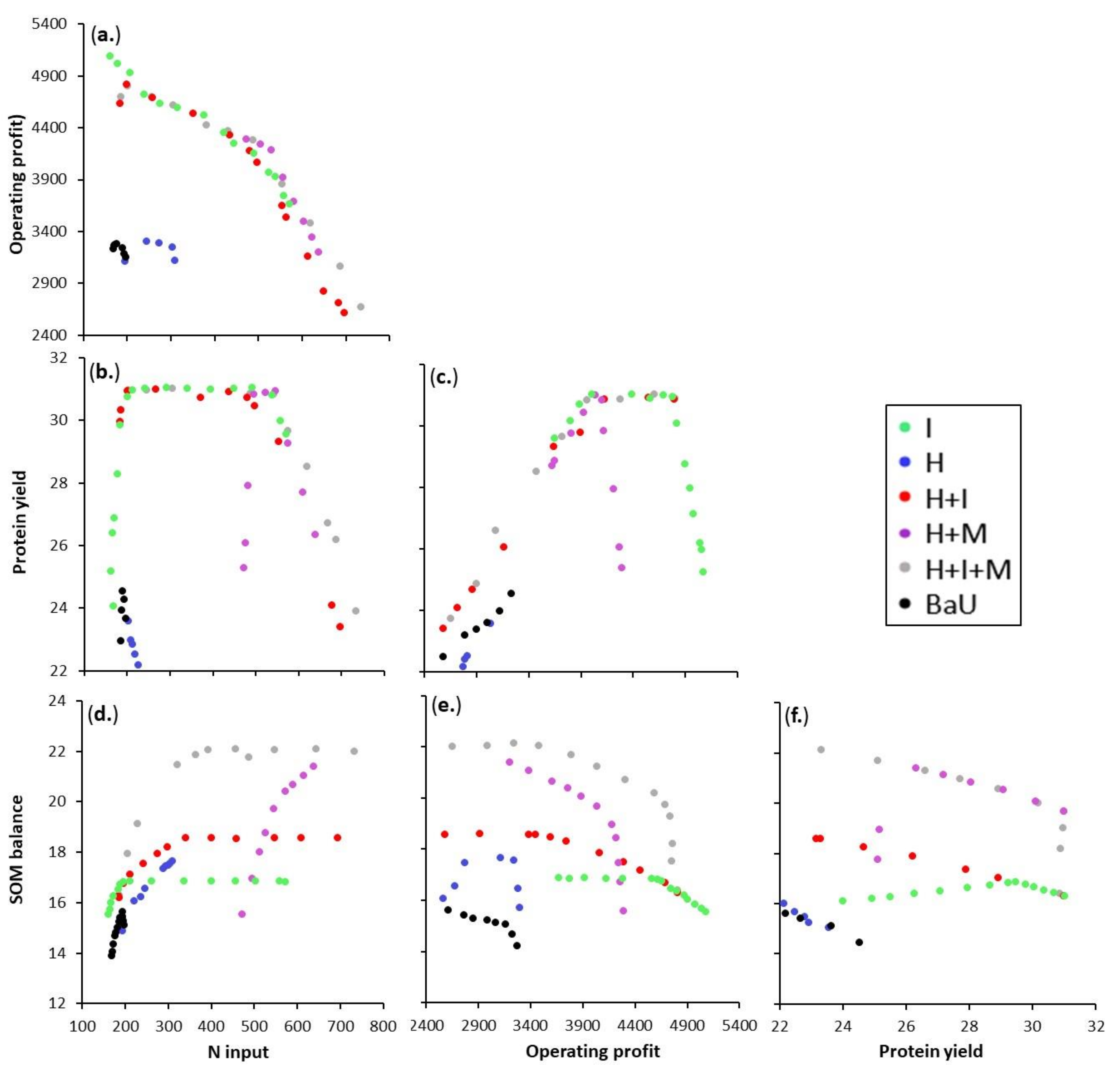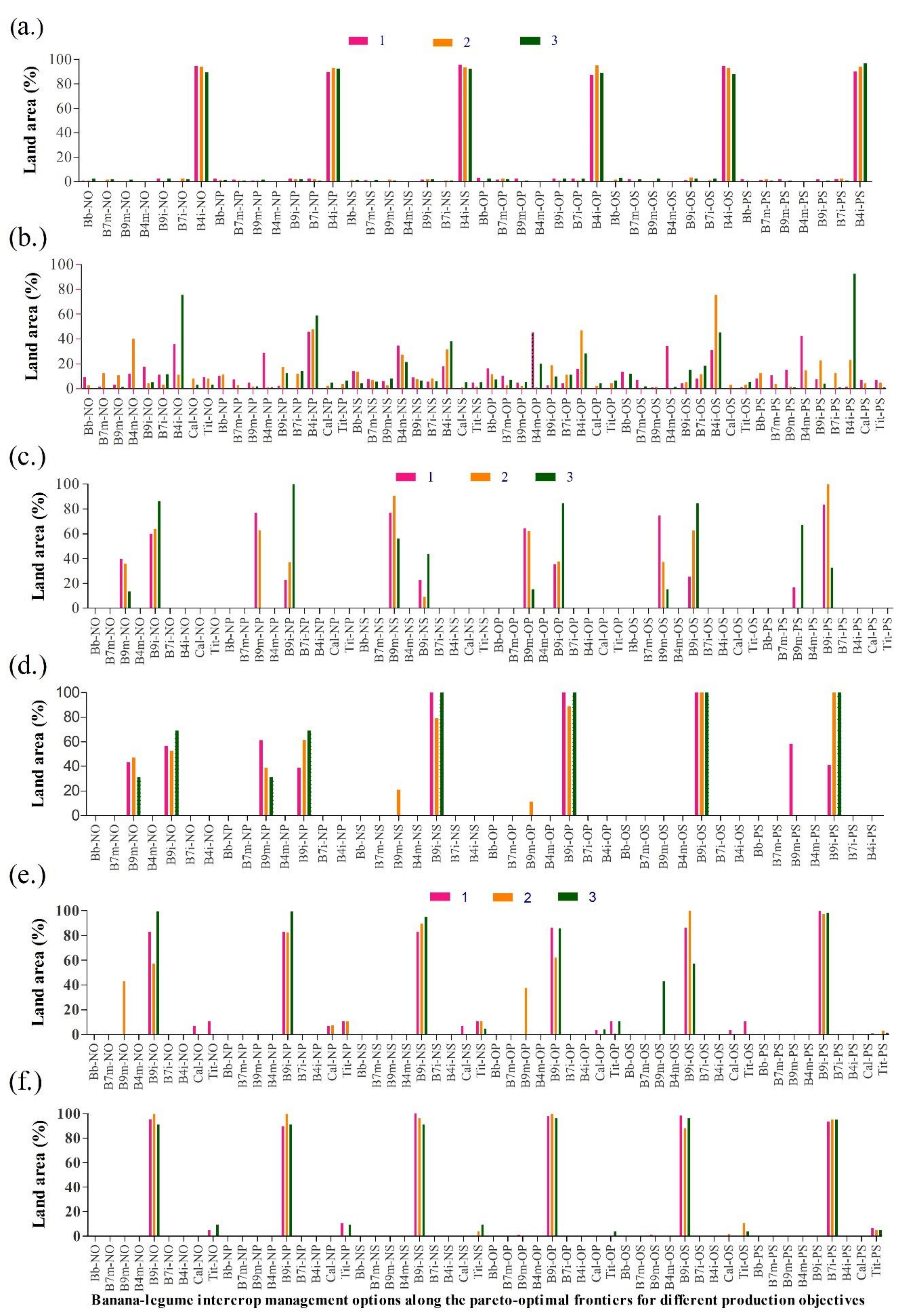A Multi-Objective Model Exploration of Banana-Canopy Management and Nutrient Input Scenarios for Optimal Banana-Legume Intercrop Performance
Abstract
1. Introduction
2. Materials and Methods
2.1. Field Experiment
2.2. The FarmDESIGN Model
2.3. Model Inputs, Outputs and Exploration
- (i)
- Business as usual (‘BaU’): This scenario benefitted only from farmyard manure applied at planting and crop residues returned to the soil. No additional external inputs were added during the three-year period of the banana crop;
- (ii)
- hedges (‘H’): Border/alley hedge crops rich in N and/or K were explored as an alternative for nutrient recycling within the system. The hedge species used in the model are calliandra (Calliandra calothyrsus) and tithonia (Tithonia diversifolia). Calliandra and tithonia have been reported to be good sources of N and K [43,44,45] that are often limiting in banana systems;
- (iii)
- inorganic input source of N, P, and K (‘I’): The model was allowed to choose between different inorganic input sources so as to bridge input gaps in the system;
- (iv)
- a combination of the two hedge species and inorganic input (‘H’ + ‘I’);
- (v)
- a combination of the two hedge species and goat manure (‘H’ + ‘M’); and
- (vi)
- a combination of the two hedge species, goat manure, and the inorganic inputs (‘H’ + ‘M’ + ‘I’).
2.4. Model Exploration
3. Results
3.1. Treatment Comparisons Prior to Exploration
3.2. Banana–Bush Bean Intercrop Model Explorations with Different Input Scenarios
3.2.1. Operating Profit
3.2.2. N Input
3.2.3. Protein Yield
3.2.4. Soil Organic Matter (SOM) Balance
3.3. Pareto-Frontier Trade-Offs and Synergies between Production Objectives
4. Discussion
5. Conclusions
Supplementary Materials
Author Contributions
Funding
Institutional Review Board Statement
Informed Consent Statement
Data Availability Statement
Acknowledgments
Conflicts of Interest
References
- FAO. 2018. Available online: http://faostat3.ao.org/browse/Q/*/E (accessed on 22 March 2018).
- Abele, S.; Twine, E.; Legg, C. Food Security in Eastern Africa and the Great Lakes. Crop Crisis Control Project Final Report to USAID. 2007, p. 110. Available online: http://c3project.iita.org/Doc/Final%20report%20C3P%20small.pdf (accessed on 18 March 2015).
- Karamura, E.B.; Turyagyenda, F.L.; Tinzaara, W.; Blomme, G.; Molina, A.; Markham, R. Xanthomonas Wilt (Xanthomonas Campestris pv. Musacearum) of Bananas in East and Central Africa. Diagnostic and Management Guide; Fountain Publishers: Kampala, Uganda, 2008. [Google Scholar]
- The World Bank Group. The World Bank Data. 2019. Available online: https://data.worldbank.org (accessed on 15 March 2019).
- Jagwe, J.; Ouma, E.; van Asten, P.; Abele, S. Banana Marketing in Rwanda, Burundi and South Kivu CIALCA Project Survey Report. 2014. Available online: https://test.cialca.org/wp-content/uploads/2018/06/6.-Banana_market_report.pdf (accessed on 15 January 2019).
- FAO. FAPDA Country Fact Sheet on Food and Agriculture Policy Trends—BURUNDI. 2015. Available online: http://www.fao.org/3/a-i4909e.pdf (accessed on 15 March 2018).
- IFAD. The Democratic Republic of Congo. 2018. Available online: https://www.ifad.org/en/web/operations/country/id/dr_congo#anchor-3 (accessed on 17 January 2019).
- Uganda Investment Authority. Agriculture. 2018. Available online: https://www.ugandainvest.go.ug/projects/ (accessed on 15 March 2019).
- Tinzaara, W.; Stoian, D.; Ocimati, W.; Kikulwe, E.; Otieno, G.; Blomme, G. Challenges and Opportunities for Smallholders in Banana Value Chains. In Achieving Sustainable Cultivation of Banana; Burleigh Dodds Science Publishing: Cambridge, UK, 2018; pp. 85–110. [Google Scholar]
- Sunday, G.; Ocen, D. Fertilizer Consumption and Fertilizer Use by Crop in Uganda. 2015. Available online: http://www.africafertilizer.org/wp-content/uploads/2017/05/FUBC-Uganda-final-report-2015.pdf (accessed on 15 March 2019).
- Nandwa, S.M.; Bekunda, M.A. Research on nutrient flows in east and Southern Africa: State-of-the-art. Agric. Ecosyst. Environ. 1998, 71, 5–18. [Google Scholar] [CrossRef]
- Ocimati, W.; Karamura, D.; Rutikanga, A.; Sivirihauma, C.; Ndungo, V.; Ntamwira, J.; Blomme, G. Agronomic practices for Musa across different agro-ecological zones in Burundi, Eastern Democratic Republic of Congo and Rwanda. In Banana Systems in the Humid Highlands of Sub-Saharan Africa: Enhancing Resilience and Productivity; Blomme, G., Vanlauwe, B., van Asten, P., Eds.; CAB International: Wallingford, UK, 2013; pp. 175–190. [Google Scholar]
- van Asten, P.J.A.; Gold, C.S.; Okech, S.H.O.; Gaidashova, S.V.; Tushemereirwe, W.; De Waele, D. Soil quality problems in East African banana systems and their relation with other yield loss factors. InfoMusa 2004, 13, 20–25. [Google Scholar]
- Ntamwira, J.; Pypers, P.; Van, A.P.; Vanlauwe, B.; Ruhigwa, B.; Lepoint, P.; Dheda, B.; Monde, T.; Kamira, M.; Blomme, G.; et al. Effect of banana leaf pruning on banana and legume yield under intercropping in farmers’ fields in eastern Democratic Republic of Congo. J. Hortic. For. 2014, 6, 72–80. [Google Scholar] [CrossRef]
- Blomme, G.; Ocimati, W.; Groot, J.; Ntamwira, J.; Bahati, L.; Kantungeko, D.; Remans, R.; Tittonell, P. Agroecological integration of shade- and drought-tolerant food/feed crops for year-round productivity in banana-based systems under rain-fed conditions in Central Africa. Acta Hortic. 2018, 1196, 41–54. [Google Scholar] [CrossRef]
- Wortmann, C.S.; Sengooba, T.; Kyamanywa, S. Banana and Bean Intercropping: Factors Affecting Bean Yield and Land Use Efficiency. Exp. Agric. 1992, 28, 287–294. [Google Scholar] [CrossRef]
- Ouma, G. Intercropping and its application to banana production in East Africa: A review. J. Plant Breed. Crop Sci. 2009, 1, 13–15. [Google Scholar]
- Ocimati, W.; Ntamwira, J.; Groot, J.; Taulya, G.; Tittonell, P.; Dhed’A, B.; Van Asten, P.; Vanlauwe, B.; Ruhigwa, B.; Blomme, G. Banana leaf pruning to facilitate annual legume intercropping as an intensification strategy in the East African highlands. Eur. J. Agron. 2019, 110, 125923. [Google Scholar] [CrossRef]
- Dapaah, H.K.; Asafu-Agyei, J.N.; Ennin, S.A.; Yamoah, C. Yield stability of cassava, maize, soya bean and cowpea intercrops. J. Agric. Sci. 2003, 140, 73–82. [Google Scholar] [CrossRef]
- Zinsou, V.; Wydra, K.; Ahohuendo, B.; Hau, B. Effects of soil amendments, inter- cropping and planting time in combination on the severity of cassava bacterial blight and yield in two ecozones of West Africa. Plant Pathol. 2004, 53, 585–595. [Google Scholar] [CrossRef]
- Amanullah, M.M.; Somasundaram, E.; Vaiyapuri, K.; Sathyamoorthi, K. Inter-cropping in cassava. Agric. Rev. 2007, 28, 179–187. [Google Scholar]
- Sileshi, G.; Akinnifesi, F.K.; Ajayi, O.C.; Chakeredza, S.; Kaonga, M.; Matakala, P.W. Contributions of agroforestry to ecosystem services in the Miombo eco-region of eastern and southern Africa. Afr. J. Environ. Sci. Technol. 2007, 1, 68–80. [Google Scholar]
- Chakeredza, S.; Hove, L.; Akinnifesi, F.K.; Franzel, S.; Ajayi, O.C.; Sileshi, G. Managing fodder trees as a solution to human–livestock food conflicts and their contribution to income generation for smallholder farmers in southern Africa. Nat. Resour. Forum. 2007, 31, 286–296. [Google Scholar] [CrossRef]
- McIntyre, B.C.; Gold, I.; Kashaija, H.; Ssali Night, E.; Bwamiki, D. Effects of legume Intercrops on soil borne pests, biomass, nutrients and soil water in banana. Biol. Fertil. Soils 2001, 34, 342–348. [Google Scholar]
- Vandermeer, J. The ecological basis of alternative agriculture. Annu. Rev. Ecol. Syst. 1995, 26, 201–224. [Google Scholar] [CrossRef]
- Ntamwira, J.; Pypers, P.; van Asten, P.; Vanlauwe, B.; Ruhigwa, B.; Lepointe, P.; Blomme, G. Effect of Leaf Pruning of Banana on Legume Yield in Banana–Legume Intercropping Systems in Eastern Democratic Republic of Congo. In Banana Systems in the Humid Highlands of Sub-Saharan Africa: Enhancing Resilience and Productivity; Blomme, G., van Austen, P., Vanlauwe, B., Eds.; CABI: Oxfordshire, UK, 2013; pp. 158–165. [Google Scholar]
- Robinson, J.C.; Anderson, T.; Eckstein, K. The influence of functional leaf removal at flower emergence on components of yield and photosynthetic compensation in banana. J. Hortic. Sci. 1992, 67, 403–410. [Google Scholar] [CrossRef]
- Blomme, G.; Ocimati, W.; Sivirihauma, C.; Vutseme, L.; Mariamu, B.; Kamira, M.; Van Schagen, B.; Ekboir, J.; Ntamwira, J. A control package revolving around the removal of single diseased banana stems is effective for the restoration of Xanthomonas wilt infected fields. Eur. J. Plant Pathol. 2017, 149, 385–400. [Google Scholar] [CrossRef]
- Groot, J.; Rossing, W.A.; Jellema, A.; Stobbelaar, D.J.; Renting, H.; Van Ittersum, M.K. Exploring multi-scale trade-offs between nature conservation, agricultural profits and landscape quality—A methodology to support discussions on land-use perspectives. Agric. Ecosyst. Environ. 2007, 120, 58–69. [Google Scholar] [CrossRef]
- Groot, J.C.J.; Oomen, G.; Rossing, W.A.H. Model-Based on Farm Design of Mixed Farming Systems. In Proceedings of the Congreso de Co-Innovación de Sistemas Sostenibles de Sustento Rural, Lavalleja, Uruguay, 28–30 April 2010; pp. 155–158. [Google Scholar]
- Janssen, S.; van Ittersum, M.K. Assessing farm innovations and responses to policies: A review of bio-economic farm models. Agric. Syst. 2007, 3, 622–636. [Google Scholar] [CrossRef]
- Mandryk, M.; Reidsma, P.; Kanellopoulos, A.; Groot, J.C.; van Ittersum, M.K. The role of farmers’ objectives in current farm practices and adaptation preferences: A case study in Flevoland, the Netherlands. Reg. Environ. Chang. 2014, 14, 1463–1478. [Google Scholar] [CrossRef]
- Cortez-Arriola, J.; Groot, J.; Rossing, W.A.; Scholberg, J.M.; Massiotti, R.D.A.; Tittonell, P. Alternative options for sustainable intensification of smallholder dairy farms in North-West Michoacán, Mexico. Agric. Syst. 2016, 144, 22–32. [Google Scholar] [CrossRef]
- Ditzler, L.; Komarek, A.M.; Chiang, T.W.; Alvarez, S.; Chatterjee, S.A.; Timler, C.; Raneri, J.E.; Estrada-Carmona, N.; Kennedy, G.; Groot, J.C. A model to examine farm household trade-offs and synergies with an application to smallholders in Vietnam. Agric. Syst. 2019, 173, 49–63. [Google Scholar] [CrossRef]
- Kempers, A.J.; Zweers, A. Ammonium determination in soil extracts by the salicylate method. Commun. Soil. Sci. Plant Anal. 1986, 17, 715–723. [Google Scholar] [CrossRef]
- Mehlich, A. Mehlich 3 soil test extractant: A modification of Mehlich 2 extractant. Commun. Soil. Sci. Plant Anal. 1984, 15, 1409–1416. [Google Scholar] [CrossRef]
- CIALCA. CIALCA Base (v1.01). 2019. Available online: https://cialca.shinyapps.io/cialca_base_2files/ (accessed on 7 January 2021).
- AATF African Agricultural Technology Foundation. Feasibility Study on Technologies for Improving Banana for Resistance Against Bacterial Wilt in Sub-Saharan Africa (Nairobi, Kenya). 2009. Available online: https://www.aatf-africa.org/wp-content/uploads/2018/11/Banana_Bacterial_Wilt_Feasibility_Study.pdf (accessed on 11 January 2021).
- Groot, J.; Rossing, W.A.H. Model-aided learning for adaptive management of natural resources: An evolutionary design perspective. Methods Ecol. Evol. 2011, 2, 643–650. [Google Scholar] [CrossRef]
- Groot, J.C.; Oomen, G.J.; Rossing, W.A. Multi-objective optimization and design of farming systems. Agric. Syst. 2012, 110, 63–77. [Google Scholar] [CrossRef]
- Goldberg, D.E. Genetic Algorithms in Search, Optimization, and Machine Learning; Addison Wesley: Reading, MA, USA, 1989. [Google Scholar]
- Groot, J.C.J. Farm DESIGN Manual—Version 4.21.0; Farming Systems Ecology Group, Wageningen University and Research: Wageningen, The Netherlands, 2018. [Google Scholar]
- Orwa, C.; Mutua, A.; Kindt, R.; Jamnadass, R.; Anthony, S. Agroforestree Database: A Tree Reference and Selection Guide Version 4.0. 2009. Available online: http://www.worldagroforestry.org/sites/treedbs/treedatabases.asp (accessed on 5 February 2019).
- Heuzé, V.; Tran, G.; Doreau, M.; Lebas, F. Calliandra (Calliandra calothyrsus) Feedipedia, a Programme by INRA, CIRAD, AFZ and FAO. 2017. Available online: https://www.feedipedia.org/node/586 (accessed on 7 April 2017).
- Heuzé, V.; Tran, G.; Giger-Reverdin, S.; Lebas, F. Mexican Sunflower (Tithonia diversifolia) Feedipedia, A Programme by INRA, CIRAD, AFZ and FAO. 2016. Available online: https://www.feedipedia.org/node/15645 (accessed on 15 March 2018).
- DeFries, R.S.; Fanzo, J.; Remans, R.; Palm, C.; Wood, S.; Anderman, T.L. Metrics for land-scarce agriculture. Science 2015, 349, 238–240. [Google Scholar] [CrossRef]
- Nyombi, K.; Van Asten, P.; Corbeels, M.; Taulya, G.; Leffelaar, P.; Giller, K.E. Mineral fertilizer response and nutrient use efficiencies of East African highland banana (Musa spp., AAA-EAHB, cv. Kisansa). Field Crops Res. 2010, 117, 38–50. [Google Scholar] [CrossRef]
- Taulya, G. East African highland bananas (Musa spp. AAA-EA) ‘worry’ more about potassium deficiency than drought stress. Field Crops Res. 2013, 151, 45–55. [Google Scholar] [CrossRef]
- Nyombi, K. Fertilizer management of Highland bananas in East Africa. Better Crops 2014, 98, 29–31. [Google Scholar]
- Hotz, C.; Abdelrahman, L.; Sison, C.; Moursi, M.; Loechl, C. A Food Composition Table for Central and Eastern Uganda; HarvestPlus: Washington, DC, USA, 2012. [Google Scholar]
- USDA. USDA Food Composition Databases. 2017. Available online: https://ndb.nal.usda.gov/ndb/search/listWall (accessed on 14 March 2019).
- Wiersum, K.F.; Rika, I.K. Calliandra calothyrsus (PROSEA). 2016. Available online: https://uses.plantnet-project.org/en/Calliandra_calothyrsus_(PROSEA) (accessed on 14 March 2019).
- Joy, J.; Raj, A.K.; Kunhamu, T.K.; Jamaludheen, V. Forage yield and nutritive quality of three-years-old calliandra (Calliandra calothyrsus Meissn.) under different management options in coconut plantations of Kerala, India. Indian J. Agrofor. 2018, 20, 11–15. [Google Scholar]
- Nguyen, V.S.; Nguyen, T.M.; Ðinh, V.B. Biomass production of Tithonia diversifolia (Wild Sunflower), soil improvement on sloping land and use as high protein foliage for feeding goats. Livest. Res. Rural Dev. 2010, 22, 151. [Google Scholar]
- Songyo. Towards Sustainable Banana Production in Central Uganda: Assessing Four Alternative Banana Cropping Systems. Master’s of Science Thesis, Wageningen University and Research, Wangenigen, The Netherlands, 2014. Available online: http://edepot.wur.nl/416414 (accessed on 15 March 2019).
- Stover, R.H.; Simmonds, N.W. Bananas, 3rd ed.; Tropical Agricultural Series; Wiley: New York, NY, USA, 1987; p. 468. [Google Scholar]
- Mukasa, H.H.; Ocan, D.; Rubaihayo, P.R.; Blomme, G. Relationships between bunch weight and plant growth characteristics of Musa spp. assessed at farm level. MusAfrica 2005, 16, 2–4. [Google Scholar]
- Bloom, A.J.; Chapin, F.S., III; Mooney, H.A. Resource limitation in plants-an economic analogy. Annu. Rev. Ecol. Syst. 1985, 16, 363–392. [Google Scholar] [CrossRef]
- Butler, G.W.; Greenwood, R.M.; Soper, K. Effects of Shading and Defoliation on the Turnover of Root and Nodule Tissue of Plants of Trifolium repens, Trifolium pratense, and Lotus uliginosus. N. Z. J. Agric. Res. 1959, 2, 415–426. [Google Scholar] [CrossRef]
- Fujita, K.; Ofosu-Budu, K.G.; Ogata, S. Biological nitrogen fixation in mixed legume-cereal cropping systems. Plant Soil 1992, 141, 155–175. [Google Scholar] [CrossRef]
- Blomme, G.; Tenkouano, A. Swennen, R. Influence of leaf removal on shoot and root growth in banana (Musa spp.). InfoMusa 2001, 10, 10–13. [Google Scholar]
- Fairhurst, T. Handbook of Integrated Soil Fertility Management; Africa Soil Health Consortium: Nairobi, Kenya, 2012. [Google Scholar]
- Ssali, H.; McIntyre, B.D.; Gold, C.S.; Kashaija, I.N.; Kizito, F. Effects of mulch and mineral fertilizer on crop, weevil and soil quality parameters in highland banana. Nutr. Cycl. Agroecosyst. 2003, 65, 141–150. [Google Scholar] [CrossRef]
- Lahav, E.; Turner, D.W. Fertilizing for High Yield—Banana; Bulletin No. 7; International Potash Institute: Berne, Switzerland, 1983; p. 62. [Google Scholar]
- Robinson, J.C. Bananas and Plantains; CAB International: Wallingford, UK, 1996. [Google Scholar]
- Ocimati, W.; Groot, J.C.J.; Tittonell, P.; Taulya, G.; Blomme, G. Effects of Xanthomonas wilt and other banana diseases on ecosystem services in banana-based agroecosystems. Acta Hortic. 2018, 1196, 19–32. [Google Scholar] [CrossRef]
- Groot, J.C.; Jellema, A.; Rossing, W.A. Designing a hedgerow network in a multifunctional agricultural landscape: Balancing trade-offs among ecological quality, landscape character and implementation costs. Eur. J. Agron. 2010, 32, 112–119. [Google Scholar] [CrossRef]
- Olabode, O.S.; Sola, O.; Akanbi, W.B.; Adesina, G.O.; Babajide, P.A. Evaluation of Tithonia diversifolia (Hemsl.) A Gray for soil improvement. World J. Agric. Sci. 2007, 3, 503–507. [Google Scholar]
- Ocimati, W. Sustainability of Banana-Based Agroecosystems Affected by Xanthomonas Wilt Disease of Banana. Ph.D. Thesis, Wageningen University, Wageningen, The Netherlands, 2019; pp. 153–179. [Google Scholar]






| Crop Treatment | Banana Leaf Treatment | Mean Yield (kg ha−1 yr−1) | Cultivation Costs (US$) * | |
|---|---|---|---|---|
| Grain Yield | Bean Residue | |||
| Bush bean monocrop | - | 1163 | 2795 | 922 |
| Banana-bush bean intercrop | 4 leaves | 562 | 1731 | - |
| 7 leaves | 515 | 1524 | - | |
| All leaves | 408 | 1098 | - | |
| Bunch Yield | Banana Residue | |||
| Banana monocrop | 4 leaves | 26720 | 7600 | 1382 |
| 7 leaves | 32840 | 9000 | 1392 | |
| All leaves | 35040 | 10100 | 1398 | |
| Banana-bush bean intercrop | 4 leaves | 23680 | 7600 | 2184 |
| 7 leaves | 33520 | 9600 | 2174 | |
| All leaves | 36840 | 10500 | 2115 | |
| Variable | Banana Monocrop | Banana-Bush Bean Intercrop | Bush Beans (Bb) | ||||
|---|---|---|---|---|---|---|---|
| B9m | B7m | B4m | B9i | B7i | B4i | ||
| Operating profit (US$ ha−1 yr−1) | 5482 | 4193 | 3794 | 5299 | 4471 | 2575 | −9 |
| N input (kg ha−1 yr−1) | 161 | 161 | 161 | 179 | 185 | 188 | 211 |
| Protein yield (persons ha−1 yr−1) | 25 | 21 | 19 | 31 | 29 | 23 | 15 |
| Soil OM balance (kg ha−1 yr−1) | 15514 | 14942 | 14152 | 16294 | 16009 | 14962 | 11393 |
| Soil K balance (kg ha−1 yr−1) | −302 | −216 | −189 | −321 | −261 | −131 | 161 |
| Soil N balance (kg ha−1 yr−1) | 47 | 67 | 74 | 45 | 62 | 94 | 164 |
| Soil P balance (kg ha−1 yr−1) | 105 | 107 | 108 | 102 | 104 | 107 | 114 |
| Input Scenarios | N Input (kg ha−1 yr−1) | Operating Profit (US$ ha−1 yr−1) | Protein Yield (Persons ha−1 yr−1) | SOM Balance (kg ha−1 yr−1) | ||||
|---|---|---|---|---|---|---|---|---|
| Min | Max | Min | Max | Min | Max | Min | Max | |
| BaU | 170 | 199 | 2575 | 3279 | 18 | 25 | 13875 | 15604 |
| H | 176 | 318 | 2524 | 3385 | 17 | 24 | 14147 | 17957 |
| I | 162 | 574 | 1403 | 5085 | 23 | 31 | 14962 | 16851 |
| H + I | 185 | 697 | 1403 | 4811 | 23 | 31 | 14962 | 18585 |
| H + M | 474 | 640 | 1321 | 4298 | 23 | 31 | 15534 | 21373 |
| H + I + M | 186 | 735 | 1321 | 4810 | 23 | 31 | 13875 | 22116 |
Publisher’s Note: MDPI stays neutral with regard to jurisdictional claims in published maps and institutional affiliations. |
© 2021 by the authors. Licensee MDPI, Basel, Switzerland. This article is an open access article distributed under the terms and conditions of the Creative Commons Attribution (CC BY) license (http://creativecommons.org/licenses/by/4.0/).
Share and Cite
Ocimati, W.; Groot, J.C.J.; Blomme, G.; Timler, C.J.; Remans, R.; Taulya, G.; Ntamwira, J.; Tittonell, P. A Multi-Objective Model Exploration of Banana-Canopy Management and Nutrient Input Scenarios for Optimal Banana-Legume Intercrop Performance. Agronomy 2021, 11, 311. https://doi.org/10.3390/agronomy11020311
Ocimati W, Groot JCJ, Blomme G, Timler CJ, Remans R, Taulya G, Ntamwira J, Tittonell P. A Multi-Objective Model Exploration of Banana-Canopy Management and Nutrient Input Scenarios for Optimal Banana-Legume Intercrop Performance. Agronomy. 2021; 11(2):311. https://doi.org/10.3390/agronomy11020311
Chicago/Turabian StyleOcimati, Walter, Jeroen C. J. Groot, Guy Blomme, Carl J. Timler, Roseline Remans, Godfrey Taulya, Jules Ntamwira, and Pablo Tittonell. 2021. "A Multi-Objective Model Exploration of Banana-Canopy Management and Nutrient Input Scenarios for Optimal Banana-Legume Intercrop Performance" Agronomy 11, no. 2: 311. https://doi.org/10.3390/agronomy11020311
APA StyleOcimati, W., Groot, J. C. J., Blomme, G., Timler, C. J., Remans, R., Taulya, G., Ntamwira, J., & Tittonell, P. (2021). A Multi-Objective Model Exploration of Banana-Canopy Management and Nutrient Input Scenarios for Optimal Banana-Legume Intercrop Performance. Agronomy, 11(2), 311. https://doi.org/10.3390/agronomy11020311









